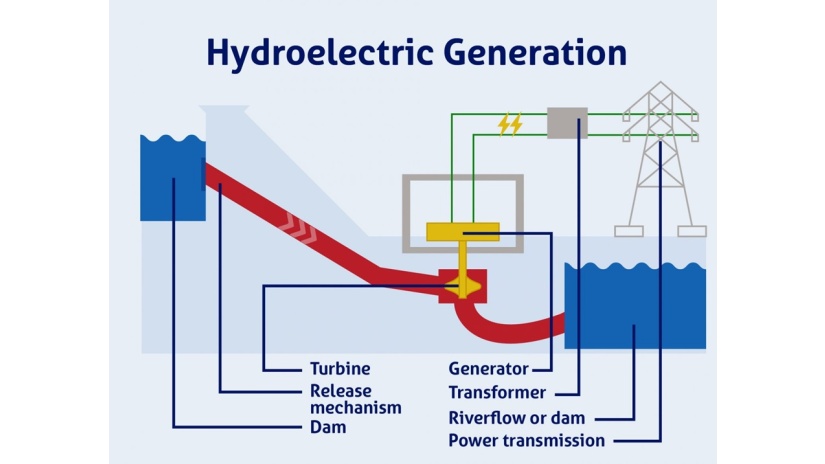Knowledge Centre
Everything you need to know about hydro power

Ordinarily, mixing water and electricity is a recipe for disaster. Yet, hydro power combines these two elements to create one of Australia's most significant renewable energy sources.
So, how exactly does this process work, and where can you find hydro power in Australia?
What is hydro power?
Hydro power, also referred to as hydroelectricity or hydro energy, is a renewable energy source that harnesses the power of moving water to produce electricity.
This is achieved by channelling water from reservoirs, rivers, or waterfalls through turbines. Over 160 countries worldwide use hydro power to generate part of their electricity.
In 2020, hydro power was among Australia's top three renewable energy sources, alongside solar and wind. During this period, hydro power accounted for six percent of the country's total renewable energy production.
How does hydro power work?
Hydro power in Australia operates by using the energy of moving water to generate electricity. Here's how it works:
Water is collected
Water is collected in reservoirs or dams, often created by building a dam across a river. The water is stored at a higher elevation than the power station.
Water is released
When electricity is needed, water is released from the reservoir. Gravity causes the water to flow downhill through large pipes called penstocks.
Turbines operate
The flowing water spins large turbines connected to generators. The turbines convert the kinetic energy of the moving water into mechanical energy, which is then used to generate electricity.
Electricity generation
The rotating turbines activate the generators, which produce electricity. This electricity is then fed into the grid and distributed to homes and businesses.
Environmental impact
While hydro power is a renewable energy source and produces no direct emissions, large-scale dams can have significant environmental impacts. These can include habitat disruption, altered water flow patterns, and impacts on fish populations.

Source: AER
What is hydro power used for?
Hydro power is primarily used for electricity generation. It contributes to the country's energy mix by providing a renewable and reliable source of power. Hydro power plants in Australia are often used for:
Baseload power
Hydro power plants can operate continuously, providing a stable source of electricity to meet the constant demand for power.
Balancing renewable energy
Hydro power is often used to complement other renewable energy sources, such as solar and wind, which can be intermittent. Hydro power can ramp up or down quickly to balance the grid.
Pumping and storage
Some hydro power plants are used for pumped storage, where water is pumped to an elevated reservoir during times of low electricity demand and then released to generate power during peak demand periods.
Supporting grid stability
Hydro power plants can help maintain grid stability by providing reactive power support and frequency regulation services.
Which is the biggest hydro power plant in Australia?
Australia's largest hydroelectricity plant is the Snowy Mountains Hydro-Electric Scheme, situated in New South Wales.
With an installed capacity of 3,800MW, it comprises 16 major dams, 5 above-ground power stations, 2 underground power stations, and nearly 150km of trans-mountain tunnels.
Remarkably, the Snowy Mountains Scheme generates approximately half of Australia's total hydro power output.
What are the benefits of hydro power?
Hydro power offers numerous advantages as a renewable, clean energy source that reduces reliance on fossil fuels. Some of the key benefits include:
Minimal impact to the environment
Hydro power has low greenhouse gas emissions compared to fossil fuels and does not produce air pollution or toxic byproducts.
Reduced greenhouse gases
By reducing greenhouse gas emissions, hydro power plays a role in mitigating climate change and global warming.
Complements other renewable energy sources
Hydro power can complement other renewable energy sources like solar and wind, providing a more stable and reliable energy supply.
Low maintenance costs
Hydro power plants generally have lower maintenance and operation costs compared to fossil fuel power plants, leading to long-term cost savings.
Flood control
Hydro power facilities can also be used for water resource management, including flood control and irrigation.
Storing energy
Some hydro power systems can store water in reservoirs, acting as a form of energy storage that can be used during times of high demand or when other renewable sources are not available.
Despite these advantages, hydro power also has its drawbacks, such as high initial costs, dependence on rainfall for optimal operation, and the time required to pump water back to the upper reservoir in pumped storage systems.
Are all hydro power stations the same?
Australia features three primary types of hydro power stations, each functioning uniquely. The most prevalent are impoundment plants, which store water to subsequently release it, generating electricity in the process.
Diversion plants, on the other hand, direct water through canals to create electricity. This method mirrors impoundment plants, using the force of water hitting the turbine to produce electricity.
Pumped storage plants, the third type, function akin to a battery, storing water for use as an electricity supply during periods of high demand. These systems, known as Pumped Hydro Energy Storage (PHES), enable the storage of hydroelectricity.
Contact Compare Energy
If you want to learn more about renewable energy resources, call the team at Compare Energy on 1300 790 106 and let us talk you through your energy options.

